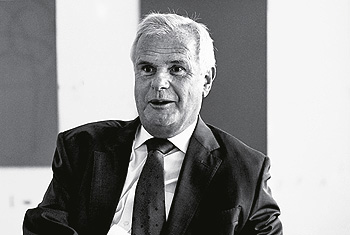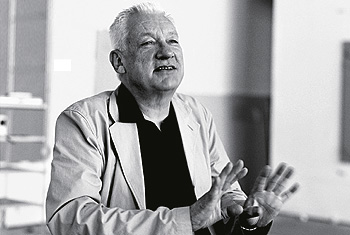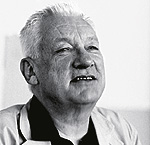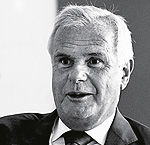Cash and Culture
Michael Craig-Martin and Paul Myners on the importance of good cultural governance at the meeting point of art and commerce
Throughout the history of art, relations between artists and their sponsors have been complex, turbulent affairs. Today, the budgets of corporate and private collectors, public and private museums are again transforming the rapport between art and commerce. In the following dialogue, British artist Michael Craig-Martin and business executive Paul Myners, who have both served as trustees of the Tate, reflect on the role of cultural governance in maintaining a balance between artistic freedom and commercial interests. Like its counterpart in the corporate realm, cultural governance considers the interests of all stakeholders, including the artist, the museum, the sponsor, and the public. In museums and galleries, the role of the board of directors is played by the board of trustees. Together, Myners and Craig-Martin explore the nature of this role, the ideal blend of artistic and commercial expertise in a trustee body, and the desirable outcome of its efforts for all of the core constituencies.
Paul Myners: The German artist A.R. Penck once said that “art lives off those who can afford it.” Is money the prime force behind art?
Michael Craig-Martin: It would be foolish to deny that money has always played a critical role in the life of art. When I started as a student in the early 60s, it was a time of optimism and that always generates financial support for activities that are seen as marginal. Art is always the first thing that is affected by economic change: by the late 60s, as I began my career as an artist, there was less optimism and less money around. But that was also a time when authority was being questioned in every field. Artists began to deliberately undermine the financial aspect of their work by making art that was meant to be uncollectable.
Myners: That was a time when art was seen as a means of expressing frustration with social structures, seeking to undermine the existing order and promote new ones.
Craig-Martin: It was also seen to have become overly formalised and too narrowly defined. There was an explosion of possibility in the role of art that I am not sure would be possible any more. Art pushed back everybody’s boundaries, not just its own. Art offered a sympathetic refuge for almost any exploratory creative activity. I think that is why contemporary art includes so many non-traditional forms, such as installation, performance, film, and video.
Myners: It does not help to think in terms of polarities – money and commerce on the one hand and art and creativity on the other, because they have always had to work together. Artists have to make a living and it is very difficult for them not to engage in a dialogue with the commercial world. And money is a means of expression. It is a mechanism we use to express fine nuances and priorities. What we must beware of is the corruption of art by money or vice versa. But we need to be aware of the risk of money corrupting artistic expression.
Craig-Martin: Artists have always had to work with clients, be it the church, the aristocracy, wealthy individuals or museums – and now corporations. The client is the enabler. From the artist’s point of view the task has always been to get the client to enable you to do what it is you want to do anyway. I once met an American artist who was horrified to find that I was a trustee of the Tate and to hear me speak positively about the institution. As an American, he saw museums as controlled by very wealthy people, while the artist’s role was to resist such people and such control. I had to explain that, while in America many of these museums are private institutions, the Tate is a public one.
Myners: I think we should resist the black and white categorisation of private and public institutions. We have seen some significant and laudable funding of art by large corporations like UBS and Deutsche Bank. I would like to see more accessibility to corporate art collections. Corporates should open their doors.
Craig-Martin: As companies seem to put more and more money into art, we’re encountering a number of different approaches to corporate collecting.
Myners: Yes, some do it for decoration of their office walls or the egos of their executives. But there are others where you feel as if the company is speaking through the art. Many companies have found the language of art powerful in terms of how they wish to be perceived, both internally and externally. Here, art is for the well-being of everybody within the organisation. At my previous company, where we had a modest art collection, there was considerable interest in what we bought and why.
“Many companies find the language of art powerful in terms of how they wish to be perceived.”

Craig-Martin: Can buying art really make a significant contribution to corporate culture?
Myners: I think it can be a pretty effective statement. It can make people proud to be part of the company. And it can help the artists, too. The history of art teaches us the role and significance of sponsors in cultivating great art. In the past it was individuals and families. Now it includes businesses.
Craig-Martin: Initially, artwork in offices was just something to put on the wall. And then the people at the top of major corporations wanted something better in their offices, something that indicated the status within. That has been cascaded down into the company. So when you go to a company that has a collection, you find works dispersed throughout the offices. From an artist’s point of view there are a few major corporations that are known to have very important collections. It feels good to have work acquired for any good collection.
Myners: Does that count as a success criterion for you as an artist?
Craig-Martin: Artists are always very conscious of the context in which their work is seen. Although for an artist sometimes that may not mean the context of the company, but the context of the other art in the collection. If the collection is really substantial, it is much more attractive to work on a commission.
Myners: Good corporate collections invariably reflect the fact that there is someone with a vision in a position of power and influence at the company. They are creating a heritage.
Craig-Martin: But if major corporations come to account for an increasing proportion of the patrons of art, I see a risk that there will be some dilution in the quality of art that is purchased. One reason why artists are so happy to have their work going to public collections is because there is a sense that this is forever. Another reason is the understandable feeling that museums make a more critical decision than one would expect of a private or corporate collection. Of course, some types of collection are absolutely extraordinary – as you said, always because of an individual. In general, though, the art market is an absurd manifestation of capitalism, where things have no intrinsic value. At any one time people are prepared to pay extraordinary amounts of money for certain things and then tastes change. But the art world has become very wealthy.
“The art market is an absurd manifestation of capitalism where things have no intrinsic value. The art world has become very wealthy.”

Myners: Maybe, but at the Tate, our government grant for purchases has not increased in nominal terms for 20 years. So expressed in terms of art inflation, it is probably down to less than five percent of its value in 1980. While we are in the market for additions to our collection, we frequently find ourselves out-resourced by other purchasers. We have a statutory obligation to maintain a collection which is representative of the best art being created today. We have to be imaginative in our acquisition policy. We cannot limit ourselves to established names. We need to be confident in our abilities to judge upcoming artists.
Craig-Martin: What’s missing in this question of corporations as the patrons of art is that we don’t have a contemporary culture of giving works to the public. And that is the only way that public collections will ever significantly grow. Recently, I spoke to someone who was a trustee at the Tate in the 70s and they never even talked about money. The museum did not have to seek funding other than its grant. If it really wanted to buy a Picasso, it could do so every other year.
Myners: And how do we develop our collection today? First of all, we have received remarkable support from artists. When an artist gives the Tate a piece, as you yourself did, they are giving an item with real monetary value. That is a major part of our programme, working with artists and benefiting from their generosity. Secondly, we mobilise a broader public through membership clubs, or syndicates. These are vehicles which allow core supporters to provide very effective help to developing our portfolio. Thirdly, we run focus committees like the Latin American or Chinese acquisitions committees. We work with corporations and we work with collectors because without them we will not maintain the dynamic collection that the public expects us to have. But those who provide the money must not be allowed to say: this is what you have to buy. That would violate the integrity of a public gallery.
Craig-Martin: I was once asked to undertake a commission for a bank. They wanted to control what I drew, and I said: What would you like me to draw? Piles of money? It must be possible for these things to work without stepping over into the realm of advertising.
Myners: When it comes to commissioning, I think it needs to be defined in terms of: We wish to give you an opportunity to create, and we don’t wish to influence that process. I think one of the great dynamic drivers here is to get closer to the creative process without restricting it, and actually to say at times: “Come on, be bold!”
Craig-Martin: The person doing the commissioning has an idea about what the work will turn out like, and the artist has a different picture in his mind. The work that results is probably different from both ideas. So there is always a risk that you, as the corporate buyer, may not be happy with the result. But on the subject of this interface between art and commerce, let me ask you something as a businessman who is also chairman of the trustees at the Tate: Given the great debate about corporate governance in the business world, shouldn’t there be a similar debate about cultural governance in the world of public museums and galleries – some attempt to define and perhaps codify the role and composition of trustee bodies? Would you say, for example, that the Tate could act as a model of cultural governance?
Myners: The Tate has a governance structure which is appropriate for the custody of a public heritage benefitting from a degree of public funding. That said, today nearly half our funding comes from non-government sources. We run the most successful art bookshop in Europe, publish an extensive range of titles and we have over 20 restaurants. We are in a commercial environment, because we need to generate revenue. But we are first and foremost an art institution and that drives our governance. We have a governance structure which comes out of law and it requires us to have three active artist trustees, of whom you were one from 1989 to 1999. So let me turn the question around: How did you as an artist feel about the interface between art and financial considerations?
Craig-Martin: These questions of governance have become much more important today because the impact of large cultural institutions is so much greater on a growing number of people. During the 1970s and 80s, when there was very little interest in contemporary art, museums were places of contemplation where there were very few people. That has now changed completely.
Myners: If you are ever feeling depressed, go to Tate Modern and feel the energy of a group of schoolchildren running down the Turbine Hall ramp, overawed by the space and about to be excited by sitting in front of art that is going to ask them questions about themselves. To me that is extraordinarily fulfilling. But there are also some pretty mundane things we have to do, and do them right. We get six million visitors a year and we employ 2,000 people, so we need business skills. Many things we do mirror the activities and risks of a commercial organisation. That said, there are also things that are very, very different. When it comes to acquisitions, these are decisions which must be directed by inspired curatorial leadership. We have a collection committee which is chaired by one of our artist trustees. Tate director Nicholas Serota takes his proposed acquisitions to the collection committee before Tate decides. What do you think of these processes?
Craig-Martin: This idea of having three of the twelve trustees at the Tate always be artists is extraordinary. I don’t know any other museum in the world where this is the case. At the Tate, there are people on the Board of Trustees who have immense experience of finance and business, there are others who looked after the monitoring, and then there are the artists. At the trustee meetings all these things were brought together, creating the balance of skills it takes to run such an institution.
Myners: So what does the artists’ contribution to the Board of Trustees look like?
Craig-Martin: Let’s put it this way: I was never invited to be on the finance committee! I think what happens in many institutions is that the people are too similar. When you have artists and leading figures from business and the financial world, that makes for a very special blend.
Myners: When I became Chairman of Tate in 2003 I instituted a governance review. We looked at the necessary competency framework and set out to blend together a trustee group with diverse backgrounds, because we need a wide range of experience. We now have a pretty rigorous selection process, and trustees serve for a four-year period. In some cases they may be invited to stay another four years but it is important for us to refresh ourselves. No trustee serves for more than eight years.
Craig-Martin: What would be the role of the artists on the board if it were up to you?
Myners: Let’s take the most recent appointment. You will be aware of Fiona Rae’s history as an exceptionally talented young artist. But at the Tate she takes the role that companies seek in the non-executive directors on their boards – the role of a constructive but challenging colleague.
Craig-Martin: As an artist trustee, I found it important not to get confused about what your responsibility was. The museum has its own director and staff, and their job is to build the collection and shape the exhibitions. It seems to me that the trustee’s world is more about maintaining an overview of what they are doing rather than getting involved in the details of their decision-making.
Myners: A really good trustee is somebody who is constantly pushing to make sure that we are confident and creative yet knowledgeable of our limitations. One of the things I have done is to ask: what skills do we have as an organisation and how can we best apply those skills? We have to address the needs of the people – the companies – who want to work with us, as well. We can’t just be a passive recipient of money. Individuals and companies want to feel they are in partnership with Tate – special friends.
Craig-Martin: The work of the trustees and the whole question of finance are all part of the back-office work that enables this institution to operate. Museums are under great pressure to come up with exhibitions that attract huge numbers of visitors. And there is a general perception that the exhibitions that are important for the Tate to stage but will not attract an enormous audience are to some extent financed by the major successes, and that you need a balance of those things. But the Tate, or any other museum, should never try to attract people at any cost, for example by staging motorcycle or fashion shows. That would be the short road to disaster and would only undermine the credibility of the institution.
Myners: If we ever had to do that at the Tate, I would regard it as a failure on my part as a trustee. We have to make sure that we don’t lurch unwisely in that direction. In one direction lies the corrosive impact of tracking attendance numbers and popularity. In the other lies the debacle of financial failure. One role of the trustees is to help the institution and its director to strike the right balance between artistic and commercial success; to preserve integrity and authority while remaining solvent.
RESUMÉ Michael Craig-Martin

Career: Michael Craig-Martin studied art at Yale, but has spent most of his working life in the UK. His first solo exhibition was staged in 1969 at the Rowan Gallery, London, and since then he has shown his works all over the world. From 1974 to 1988, Craig-Martin taught at Goldsmiths College, London, returning there in 1993 as Millard Professor of Fine Art. His students included Damien Hirst, Gary Hume, and Julian Opie. He was a trustee of the Tate from 1989 to 1999, the period leading up to the creation of Tate Modern. As one of a group of 23 British artists he agreed to donate a work to the Tate to complement its collection. Michael Craig-Martin can be contacted at: www.michaelcraig-martin.com.
Credo: “I have tried to discover what is special through an exploration of the commonplace.”
RESUMÉ Paul Myners

Career: Paul Myners is Chairman of Marks & Spencer and of the Guardian newspaper group. He is also Chairman of the Trustees at Tate, the organisation behind Britain’s four Tate Galleries. In 2001 he retired after 17 years as Chairman of Gartmore Investment Management. His boardroom experience includes time as an executive director at NatWest Bank, and a non-executive director of Celltech, Lloyd’s of London, mm02, Orange, and Powergen. He was made Commander of the British Empire in 2003 for services to innovation in finance. Dubbed a “fund management guru”, Myners recently called for a new governance code for the UK investment industry. He recently joined the Court of the Bank of England.
Credo: “Money is a means of expression – a mechanism we use to express fine nuances and priorities.”
PHOTOS: RÜDIGER NEHMZOW





